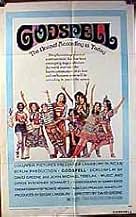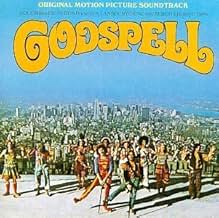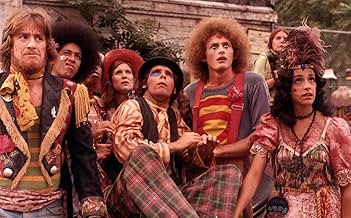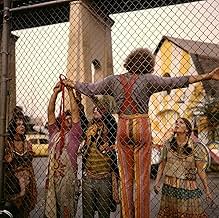Godspell
Ajouter une intrigue dans votre langueAn adaption of the musical, in a modern-day song-and-dance recreation of the Gospel of St. Matthew.An adaption of the musical, in a modern-day song-and-dance recreation of the Gospel of St. Matthew.An adaption of the musical, in a modern-day song-and-dance recreation of the Gospel of St. Matthew.
- Réalisation
- Scénario
- Casting principal
- Récompenses
- 2 nominations au total
- Ballet Rehearsal Dancer
- (non crédité)
- Homeless Man
- (non crédité)
- Garment Salesman
- (non crédité)
- Pharisee Monster
- (voix)
- (non crédité)
Avis à la une
That said, the film version merits special reference in light of the recent deaths of two of its principals: David Greene, who directed and co-wrote the screenplay, with Tebelak; and actress/singer Lynne Thigpen, who was a member of the 10-actor ensemble cast of the film.
Set in a New York City not yet recognizable to a generation destined to grow up in the shadow of 9/11, Godspell the movie is highlighted with spectacular moments that are best described as incredible. Its expanded opening number begins silently on the Brooklyn Bridge, as David Haskell, portraying both John the Baptist and Judas Iscariot, walks into the heart of Manhattan, hoping that his fellow New Yorkers will indeed "Prepare ye the way of the Lord." Jesus, portrayed by Victor Garber (who had a tremendous singing voice in those days), is depicted as a kind of manchild/Superman icon, determined to save the world through his ministry of three years. The ten actors then cavort across the screen over the next 95 or so minutes, telling parables in a raucously funny, delightfully rockin' manner.
In its final sequences, however, the film turns understandably dark, as Garber/Jesus confronts his ultimate destiny. Before long, the epic Finale, in which Garber, tied by his wrists to a chain-link fence, depicts the Crucifixion in horrifyingly simple terms; all the while, the other nine actors scream horribly as the rocking Schwartz score howls to its otherworldly symphonic conclusion.
With the coming of the dawn, the actors carry off their "dead" leader and vanish into the maelstrom of Manhattan, in a closing image that will shake you to its foundations, even as you groove to Paul Shaffer's awesome keyboard action during the expanded end-credit sequence.
The present generation knows Lynne Thigpen as a brilliant actress/singer and performer whose subsequent knack for portraying motherly or grandmotherly roles was no doubt spawned by her experience in the Godspell movie. To a whole universe of kids, however, she will always be known as simply "The Chief." If you were, as I was, a regular viewer of PBS Kids' Where in the World is Carmen Sandiego?, and its eventual spinoff, Where in Time is Carmen Sandiego?, you need not be made familiar with the Chief. She was tough, motherly, no-nonsense --- but she knew how to teach fans a thing or two, whether it was the power of geography or the realm of history.
Director David Greene, who died at the age of 82, was the fellow responsible for bringing the spectacular images of the Godspell film to the screen. It remains perhaps his most famous such feature, the only one wherein one could suggest that he was properly in tune with the youth of the 70s. Perhaps, even now, it is this that causes most folks to compare this film against Norman Jewison's film version of Jesus Christ Superstar. Both films, frankly, are what they are. No more, no less.
Enjoy, then, Godspell the movie --- but remember that you are also witnessing the blossoming of two of the unique talents who brought it to life: David Greene, director; Lynne Thigpen, star. So long, you two. We'll miss ya.
Godspell was conceived by John Michael Tebelak, who upon reading the gospels discovered joy, - "Joy! I found a great joy, a simplicity" However a visit to a church to experience this joy was totally disappointing, he knew at once what he must do.
Tebelak brings his discovery alive by way of the gospel of Matthew; his set is central New York City, a place over flowing with people caught in the hustle and bustle of daily routine. Out of the crowds he separates his cast, setting them free from the mundane routines of daily inner city life. They come together at a fountain where they frolic in the water seemingly without any care for the routines they have left behind. John played by David Haskell baptises each one in turn, Jesus played by Victor Garber appears and he to is baptised, rising from the water complete with superman tee shirt symbolically marking him as "master". The cast then is set apart as the "masters" disciples as each receives the symbolic mark of Jesus with face paint. Together now, dressed in flamboyant opp shop clothing, vibrant colours, face paint and "big" hair they have developed a sense of community that stands out in this over sized set, they have become a band of disciples.
The band proceeds through the empty city stopping at significant landmarks to play out messages from the gospel. These messages are focused on the teachings of Christ mainly through the parables, interestingly the disciples participate in the teaching, this gives a sense of inclusiveness that draws the audience into the message. Most of the critical points of the gospel are covered, such as Gethsemane, the last supper, the betrayal, and the crucifixion which at first seems a little bizarre but it also gives one a sense of participation and connectiveness, however the resurrection is left out. Their teaching is supported by the use of song and music, mime and dance, coupled with comedy; this blend achieves the joyful portrayal of the gospel that Tebelak desired.
The portrayal of Jesus as a clown may have been offensive to some, however this reviewer found it to be refreshing, the clown communicates joy while communicating the seriousness of the gospel message. He reminds us that the gospel is a message of great joy and humility, love and peace, of triumph and victory. However in saying that there are some aspects that don't fit with our understanding, for instance the betrayal scene, Jesus kisses Judas. Then it does finish with a question hanging over it, that being, why no resurrection scene? Or maybe there was, perhaps the grand finale represents the risen Jesus, carried lifted high into the crowded streets, it gives a sense of inclusiveness, that somehow Jesus lives on in each one of us.
A fun movie that you just have to participate with, and at the same time a serious message is communicated.
I was having a conversation with a friend recently (he is a pastor) and I told him that I've always felt this movie wasn't made solely for Christians. In the 70's, there were a lot of young people looking for meaning in their lives, and I firmly believe Godspell was partially an attempt to reach out to those folks.
Many reviewers have had issues with the movie - John the Baptist and Judas are played by the same person, and while the crucifixion is addressed, the resurrection is not. Some have called it sacrilegious, others have found it offensive. However, if you were a young person in the 70's who was looking for some direction and wanted to find out about the basic teachings of Jesus Christ, what better way than to see a movie full of catchy pop songs and a cast of joyful young people being brought to him in (then) modern New York? Even if you were already a young Christian, you now had a way to celebrate the teachings of Christ with a style of music you were probably listening to anyway. I absolutely believe that this movie had a relatability that might have been missing in some of these people's lives. Bear in mind that the original stage version was written by a college student working on his masters.
Yes, the movie is dated and silly and overacted and hammy in parts. There is a lot of skipping, singing, acting out of parables and dancing going on while most cast members are wearing clownish outfits. All of that being said, I have never seen such heartfelt joy while a message was being given - the cast looks like they are having the time of their lives. The mood does become quite somber and sad towards the end, but the movie ends on an upbeat note of hope.
If I'm not mistaken, all of the cast members were unknown on the big screen when the movie was released. I think casting unknowns was a good move - I don't think it would have packed the same punch or had the same level of relatability if it had bigger names.
I wanted to make a comment regarding the song "Beautiful City". I don't know what the original meaning was for sure, but my take away from it has always been that now that the cast has been taught, they can spread the word to others and help them build a strong foundation that isn't made of alabaster and chrome. Some have thought the song wasn't appropriate for the movie - I guess it all depends on your interpretation.
So taken in the proper cultural perspective, Godspell is a powerful, uplifting and moving film about the basic teachings and crucifixion of Christ done '70s style. If you think you can get past the few discrepancies and the clownish clothing, it is worth a watch. And, again, you don't have to be a Christian to enjoy it.
Le saviez-vous
- AnecdotesVictor Garber's movie debut.
- GaffesDuring the baptism scene on Bethesda Terrace, a man on Central Park Lake is visible in 3 separate shots, frantically trying to row his boat out of the scene.
- Citations
Jesus: Now, how can you take a speck of sawdust out of your brother's eye when all the time there's this great plank in your own?
Judas: I don't know. How can you take a speck of sawdust out of your brother's eye when all the time there's this great plank in your own?
Jesus: You hypocrite!
Judas: [confused cry of alarm] Wha-ha?
Jesus: First you take the plank out of your own eye so you can see clearly to take the speck of sawdust out of your brother's!
Judas: Wait a minute! That's no answer to the question!
Jesus: Did I promise you an answer to the question?
Judas: Ah... No.
- Crédits fousThe end credits include an infinity frames effect. A sixteen second film of a busy street is shown, and then the right and bottom of the frame is frozen in a sideways capital L. This then becomes the frame for the next iteration of the film, which in turn leaves its right and bottom edges as a frame for the next film. Over the frames and film are played thumbnails of the actors, then credit cards and finally a credit scroll.
- ConnexionsFeatured in Hollywood Rocks the Movies: The 1970s (2002)
- Bandes originalesBy My Side
Music and Lyrics by Peggy Gordon and Jay Hamburger
Performed by Katie Hanley (uncredited) and Company (uncredited)
Meilleurs choix
- How long is Godspell?Alimenté par Alexa
Détails
- Date de sortie
- Pays d’origine
- Site officiel
- Langues
- Aussi connu sous le nom de
- Godspell - Folgt dem Herrn!
- Lieux de tournage
- World Trade Center, Manhattan, Ville de New York, New York, États-Unis(All for the Best)
- Société de production
- Voir plus de crédits d'entreprise sur IMDbPro
Box-office
- Budget
- 1 300 000 $US (estimé)
- Durée
- 1h 43min(103 min)
- Couleur
- Mixage



























